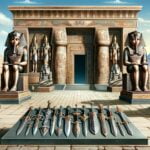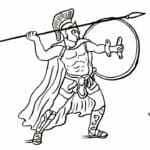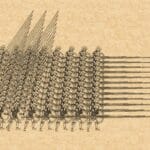Have you ever wondered what it was like to be a soldier in ancient Greece? Imagine the clash of bronze, the ominous wall of shields, and a mighty army moving as one. This was the essence of the Greek phalanx, and it all began with their armor. More than just old helmets and swords, it’s a story of innovative design, outstanding craftsmanship, and how a soldier’s equipment could determine victory or defeat. We’ll explore the secrets of their armor, from its early forms to its peak, tracing its evolution and understanding its effectiveness. We’ll examine the metalwork, the social significance of wearing quality armor, and how different soldier types used specialized gear for their unique roles. For more images of ancient Greece, see pictures here. Prepare for an exciting journey into the world of ancient Greek military prowess!
A Deep Dive into Ancient Greece Armor
Picture yourself on an ancient Greek battlefield, the air filled with dust and the sounds of clashing metal. Heavily armed hoplites stand shoulder to shoulder, an imposing wall of bronze and muscle. Their armor was not merely protection; it was a symbol of status and military power. Delve into the captivating world of ancient Greek armor! How did armor influence ancient Greek society and warfare?
The Hoplite’s Panoply: An Evolution of Protection – From Linen to Bronze
Ancient Greek hoplite armor was far from static; it evolved over centuries, reflecting advances in metalworking and battlefield tactics. Early hoplites, around 1600-1100 BCE (the Mycenaean period), wore simpler bronze armor: basic breastplates and helmets that were functional.
By the Classical era (roughly 5th-4th centuries BCE), hoplite equipment became considerably more sophisticated. The dory (a long spear, about 6.5 feet) was incredibly effective in the tightly packed phalanx formation, demanding armor to withstand close-quarters combat.
The linothorax, a linen corselet resembling a strong, layered linen jacket, was a fascinating alternative to heavy bronze breastplates. Surprisingly effective, it offered reasonable protection while being lighter and more flexible. Iron also played a role, though bronze remained significant. Why was linen so effective for armor?
Archaeological discoveries such as the Dendra armor demonstrate incredibly detailed craftsmanship, showing how serious the ancient Greeks were about their armor! Debates continue about the effectiveness of different armor types and the extent of bronze versus iron use. Research is ongoing, making ancient Greek armor a constantly evolving field of study.
Beyond the Hoplites: Diverse Warriors, Diverse Gear – Peltasts, Psiloi, and Spartan Warriors
Not every Greek soldier was a heavily armored hoplite. Consider peltasts, lighter infantry armed with smaller shields and javelins, and psiloi, lightly armed skirmishers who relied on speed and agility. Their equipment reflected their roles, a stark contrast between a Spartan hoplite in full armor and a nimble peltast. This variety highlights the adaptability of Greek military technology, where lighter gear provided speed and flexibility for flanking maneuvers or harassing the enemy.
The Phalanx: Armor’s Role in a Powerful Formation – Spear and Shield Tactics
The phalanx, the famously dense hoplite formation, is crucial to understanding Greek armor design. The large aspis shield provided both personal protection and a linked defensive wall. These shields, along with the dory spears, allowed hoplites to defend effectively and counterattack as a cohesive unit. Later, the longer Macedonian sarissa spear amplified the phalanx’s power, creating an impenetrable wall of shields and spears.
Materials, Metalworking, and Society: The Human Side of Armor – Social Status
Creating this armor required significant metallurgical skill to produce bronze and, later, iron. The effort and cost meant only wealthier citizens could afford the full hoplite panoply, creating a social divide between the heavily armored elite and lightly armed soldiers. Armor reflected social standing, with wealthier citizens affording higher-quality armor, enhancing their effectiveness in battle.
A Lasting Legacy: Beyond Metal – Influence on Military Technology
Ancient Greek armor’s legacy extends beyond the battlefield. The ingenuity and craftsmanship showcase an impressive level of technology and military thinking. Their innovations, blending practicality and social structure, significantly impacted ancient warfare and influenced later societies. Studying ancient Greek armor reveals ancient Greek culture, values, and the complex relationship between technology, tactics, and society, offering insights into the past with each new discovery.
How Did Linothorax Armor Stack Up Against Bronze?
Key Points:
- The linothorax, a linen-based armor, was a lighter, cheaper alternative to bronze, broadening military participation.
- Its effectiveness remains debated due to limited physical evidence, but modern recreations offer potential insights.
- Experiments suggest protective qualities increased with layering and treatment, making it a cost-effective solution.
- Bronze provided better protection but at a higher cost and reduced mobility, affecting battlefield agility.
- Armor choice reflected a soldier’s role, wealth, and the tactical needs of different units.
The Evolution of Hoplite Protection – From Bronze to Linen Corsets
Imagine a hoplite battlefield, with heavily armed Greek infantrymen. Their armor was not uniform. Early hoplites relied heavily on bronze, with beautiful but expensive breastplates and helmets. Think of it as the luxury car of ancient armor.
Over time, linen entered the scene with the linothorax, more than just a simple tunic. Multiple linen layers, treated with glue or resin, created a surprisingly tough defense—a layered cake of protection. This innovation made armor accessible to more soldiers, like a more affordable, practical sedan.
But how did ancient Greek linothorax armor compare to bronze curiasses regarding battlefield effectiveness? This question has puzzled historians for centuries. Artistic depictions offer clues but can be subjective. The lack of surviving linothoraces limits our knowledge, and modern reconstructions attempt to answer this, yielding different results due to process variations.
Beyond the Hoplite: Diverse Greek Armors – Peltasts and Light Infantry
The hoplite wasn’t alone. Lighter troops such as peltasts and psiloi had different armor needs. The peltast, a lightly armed skirmisher, valued agility over heavy protection, reflected in their leather shields. The psiloi, with their light equipment and focus on speed, needed even less protection, demonstrating how armor’s role intertwined with a soldier’s battlefield function.
The Phalanx and its Influence on Armor Design – Shield Formations
The phalanx fundamentally shaped armor design, emphasizing shields as much as body armor. A hoplite’s large shield was crucial for protecting the soldier himself and contributing to the phalanx’s overall defense. The adoption of the sarissa, a longer spear, further emphasized coordinated protection within the formation as the phalanx adapted to new tactical challenges.
Metallurgy and Social Structure – Wealth and Armor
Bronze was costly, requiring expertise and resources to produce, with the ability to afford it reflecting a soldier’s social status. Linen, more available, allowed more soldiers to equip themselves, even if the protection was less substantial. Armor choice defined a soldier’s place in society.
Experimental Archaeology and the Dendra Armor – Reconstructing Ancient Armor
Modern experiments, such as Dendra armor reconstructions, improve our understanding of ancient materials and their capabilities. This research improves our knowledge of ancient materials in armor, highlighting the challenges of recreating ancient techniques and the uncertainties involved, aiming to understand how these materials behaved in actual combat.
Unveiling Ancient Greek Shield Design: Materials and Construction
Key Insights:
- Ancient Greek shields, notably the aspis and hoplon, were vital to hoplite warfare, mirroring advancements in metallurgy and societal structures.
- Materials included wood, leather, and bronze, with debated bronze application.
- Shield design evolved with phalanx tactics, influencing combat effectiveness and soldier mobility.
- Shield decorations held symbolic and religious significance, creating group identity.
- The weight and size of hoplite shields influenced military organization and demanded strength and training.
The Hoplite’s Shield: Evolution of Defensive Strategies
Imagine the clash of bronze, the crowd’s roar, and a sea of shields advancing as one. That’s the Greek hoplite world, where his shield was his life. Let’s examine Ancient Greek Shield Design: Materials and Construction, exploring its evolution.
Early Mycenaean shields were simpler, made of wood and leather. By the Classical period, the iconic aspis (and later the hoplon) dominated, circular, about a meter in diameter, and weighing 7-8 kilograms. Their construction was an engineering marvel, with a wooden frame covered in oxhide and strengthened by linen layers. The extent of bronze use, whether full facing or just rim and boss reinforcement, remains debated.
Beyond the Hoplite: Shields for Diverse Warriors – Peltasts and Psiloi
The diverse Greek army included lighter infantry—peltasts and psiloi—using smaller, lighter shields suited for their roles. Peltasts wielded smaller, crescent-shaped shields (peltai) for mobility, while psiloi, light skirmishers, relied on speed and agility, carrying at most a small shield for minimal protection.
The Phalanx: Shield Wall and Tactical Doctrine – Infantry Warfare
The hoplite’s shield was critical to the phalanx formation, creating an impenetrable wall and frustrating enemy assaults. The shields’ weight and size dictated hoplite training and movements. They couldn’t be nimble but were formidable. This close-order combat influenced shield design, reflecting the tactical realities of the phalanx. Longer spears (sarissas) added another dimension, requiring specific hoplite positioning and shield manipulation.
Materials and the Making of a Warrior – Bronze and Iron
Let’s delve deeper into Ancient Greek Shield Design: Materials and Construction. Bronze working was a crucial skill, dictating the quality of equipment. Iron, while more common, remained expensive. The cost of shields had implications, creating a connection between class, military service, and the societal structure of ancient Greece.
The Legacy of the Greek Shield – Warfare Innovation
The ancient Greek shield, a testament to ingenuity, influenced military technology for centuries. It’s a symbol of a formidable military machine and a defining element of a rich culture, providing a remarkable window into Greek society and revealing an interplay of technology, warfare, and society.
Ancient Greek Helmet Evolution: Design, Materials, and Effectiveness
Key Takeaways:
- Ancient Greek helmets transformed dramatically, showing advancements in metallurgy, evolving warfare tactics, and shifting aesthetics.
- Early designs were rudimentary, often using boar tusks, while later iterations used bronze and iron, showcasing craftsmanship.
- Helmet design responded to battlefield demands. The Corinthian helmet prioritized protection, while later styles prioritized visibility and audibility.
- The relationship between helmet design, materials, and effectiveness is complex, influenced by social class, military organization, and the Greek armies’ fighting style.
From Bronze Age Rudiments to Sophisticated Designs – Ancient Craftsman
The story of Ancient Greek Helmet Evolution: Design, Materials, and Effectiveness begins simply. Early Greek warriors made do with what they could find, like crude boar tusk helmets. Though not the image that springs to mind, these designs laid the groundwork for later innovations. As bronzeworking improved, so did helmet construction, offering better head protection.
The Rise of the Iconic Corinthian Helmet – Protective Headgear
By the Archaic period, the iconic Corinthian helmet emerged. This full-faced bronze design provided exceptional protection, shielding the wearer’s head and face in close-quarters combat. However, this protection came at the cost of limited visibility and hearing. Could this design be truly effective? Weighing the pros and cons is important.
| Feature | Corinthian Helmet | Later Helmet Designs (e.g., Attic, Chalcidian) |
|---|---|---|
| Protection | Excellent | Good to moderate |
| Visibility | Poor | Good |
| Hearing | Poor | Good |
| Weight | Heavy | Lighter |
| Mobility | Slightly impeded | Greater freedom of movement |
Adapting to Change: Open-Faced Designs – Adaptive Warfare
The Corinthian helmet’s limitations spurred innovation. Open-faced helmets, such as the Attic and Chalcidian types, grew popular, offering improved visibility and hearing during more fluid battlefield maneuvers of the Classical and Hellenistic periods. These changes represented a response to evolving warfare tactics. What advantages did these designs offer? Enhanced sensory awareness, offset by reduced protection, illustrates a continuous negotiation between protection and functionality.
Metallurgy and Military Might – Ancient Metallurgy
The effectiveness of any helmet depended on the metallurgical advancements. The shift from bronze to iron impacted helmet technology, with iron offering strength and durability but presenting challenges. Skilled smiths held crucial roles in Greek society, their skills vital to producing weaponry and equipment. The cost of armor, reflecting these skills and materials, linked to the social and military hierarchy.
The Phalanx and Its Protective Role – Warfare Tactics
The design and effectiveness of Greek helmets intertwined with the phalanx formation. The need for close-order combat shaped the emphasis on protective armor. The development of longer spears, such as the sarissa, influenced the need for adaptable helmets that offered improved maneuverability while maintaining protection.
- Ancient Greece Aristocracy: Rise and Fall of Power - August 9, 2025
- Rediscover the Bad Girls of Ancient Greece: A Feminist Retelling - August 9, 2025
- Discover Ancient Greece Weapons: A Comprehensive Guide to Military Technology - August 8, 2025















